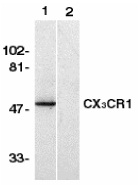CX3CR1 antibody

Rabbit anti Human CX3CR1 (N-Terminal)
- Product Type
- Polyclonal Antibody
- Isotype
- Polyclonal IgG
- Specificity
- CX3CR1
- Region
- (N-TERMINAL)
| Rabbit anti Human CX3CR1 antibody recognizes the N-terminal region of Human CX3CR1, a 40.4 kDa seven trans-membrane protein. CX3CR1, also known as fractalkine receptor, is the receptor for CX3CL1 and acts as a co-receptor with CD4 for the HIV-1 envelope protein. It is expressed in a variety of human tissues and mediates leucocyte adhesion and migration. |
- Target Species
- Human
- Species Cross-Reactivity
-
Target Species Cross Reactivity Rat Mouse - N.B. Antibody reactivity and working conditions may vary between species.
- Product Form
- Purified IgG - liquid
- Antiserum Preparation
- Antiserum to human CX3CR1 (NT) was raised by repeated immunisation of rabbits with highly purified antigen. Purified IgG was prepared from whole serum by affinity chromatography.
- Buffer Solution
- Phosphate buffered saline
- Preservative Stabilisers
- 0.02% Sodium Azide (NaN3)
- Immunogen
- A peptide corresponding to amino acids 2-21 of human CX3CR1.
- Approx. Protein Concentrations
- IgG concentration 1.0mg/ml
- Regulatory
- For research purposes only
- Guarantee
- 12 months from date of despatch
Avoid repeated freezing and thawing as this may denature the antibody. Storage in frost-free freezers is not recommended.
| Application Name | Verified | Min Dilution | Max Dilution |
|---|---|---|---|
| Immunohistology - Paraffin 1 | 2.0ug/ml | ||
| Western Blotting | 0.5 | 1.0ug/ml |
- 1This product requires antigen retrieval using heat treatment prior to staining of paraffin sections.Sodium citrate buffer pH 6.0 is recommended for this purpose.
- Histology Positive Control Tissue
- Human heart
- Western Blotting
- AHP1589 detects a band of approximately 50kDa in human spleen cell lysates.
| Description | Product Code | Applications | Pack Size | List Price | Your Price | Quantity | |
|---|---|---|---|---|---|---|---|
| Goat anti Rabbit IgG (Fc):Biotin | STAR121B | E WB | 1 mg |
|
Log in | ||
| List Price | Your Price | ||||||
|
|
Log in | ||||||
| Description | Goat anti Rabbit IgG (Fc):Biotin | ||||||
| Goat anti Rabbit IgG (Fc):FITC | STAR121F | F | 1 mg |
|
Log in | ||
| List Price | Your Price | ||||||
|
|
Log in | ||||||
| Description | Goat anti Rabbit IgG (Fc):FITC | ||||||
| Goat anti Rabbit IgG (Fc):HRP | STAR121P | E WB | 1 mg |
|
Log in | ||
| List Price | Your Price | ||||||
|
|
Log in | ||||||
| Description | Goat anti Rabbit IgG (Fc):HRP | ||||||
| Goat anti Rabbit IgG (H/L):HRP | STAR124P | C E WB | 1 mg |
|
Log in | ||
| List Price | Your Price | ||||||
|
|
Log in | ||||||
| Description | Goat anti Rabbit IgG (H/L):HRP | ||||||
| Sheep anti Rabbit IgG:RPE | STAR35A | F | 1 ml |
|
Log in | ||
| List Price | Your Price | ||||||
|
|
Log in | ||||||
| Description | Sheep anti Rabbit IgG:RPE | ||||||
| Description | Product Code | Applications | Pack Size | List Price | Your Price | Quantity | |
|---|---|---|---|---|---|---|---|
| Antigen Retrieval Buffer, pH8.0 | BUF025A | P | 500 ml | Log in | |||
| List Price | Your Price | ||||||
| Log in | |||||||
| Description | Antigen Retrieval Buffer, pH8.0 | ||||||
| TidyBlot Western Blot Detection Reagent:HRP | STAR209P | WB * | 0.5 ml | Log in | |||
| List Price | Your Price | ||||||
| Log in | |||||||
| Description | TidyBlot Western Blot Detection Reagent:HRP | ||||||
References for CX3CR1 antibody
-
Viladomiu, M. et al. (2017) Cooperation of Gastric Mononuclear Phagocytes with Helicobacter pylori during Colonization.
J Immunol. 198 (8): 3195-204. -
Lorenzini, I. et al. (2020) Activated iPSC-microglia from C9orf72 ALS/FTD patients exhibit endosomal-lysosomal dysfunction
bioRxiv 2020.09.03.277459. 03 Sep [Epub ahead of print].
Further Reading
-
Combadiere, C. et al. (1995) Cloning, chromosomal localization, and RNA expression of a human beta chemokine receptor-like gene.
DNA Cell Biol. 14 (8): 673-80. -
Raport, C.J. et al. (1995) The orphan G-protein-coupled receptor-encoding gene V28 is closely related to genes for chemokine receptors and is expressed in lymphoid and neural tissues.
Gene. 163 (2): 295-9. -
Combadiere, C. et al. (1998) Gene cloning, RNA distribution, and functional expression of mCX3CR1, a mouse chemotactic receptor for the CX3C chemokine fractalkine.
Biochem Biophys Res Commun. 253 (3): 728-32. -
Combadiere, C. et al. (1998) Identification of CX3CR1. A chemotactic receptor for the human CX3C chemokine fractalkine and a fusion coreceptor for HIV-1.
J Biol Chem. 273 (37): 23799-804.
- Synonyms
- Fractalkine Receptor
- RRID
- AB_2087421
- UniProt
- P49238
- Entrez Gene
- CX3CR1
- GO Terms
- GO:0007155 cell adhesion
- GO:0004950 chemokine receptor activity
- GO:0005887 integral to plasma membrane
- GO:0006968 cellular defense response
- GO:0009611 response to wounding
- GO:0044419 interspecies interaction between organisms
AHP1589
If you cannot find the batch/lot you are looking for please contact our technical support team for assistance.
Please Note: All Products are "FOR RESEARCH PURPOSES ONLY"
View all Anti-Human ProductsAlways be the first to know.
When we launch new products and resources to help you achieve more in the lab.
Yes, sign me up